7 Practical annotation with FLEx
Learning Objectives
- Learn to enter connected text in FLEx
- Learn the basics of annotation and concordance use for improved analysis
7.1 Using FLEx
In this section, we provide a tutorial on how to use the FieldWorks Language Explorer (FLEx) software. The software can be used in conjunction with the work that you will do in SayMore. SayMore is the software used in earlier modules to manage your data and also to create a first-pass transcription and translation.
Once you have done that, you can take just the transcription, and bring it to FLEx, and further create detailed annotations which build on the translation that you put in SayMore. There are several reasons why we want to use a program like FLEx for this. First, FLEx allows us to analyze data that is from connected texts. We have a tendency to use sentences that are elicited in isolation and for targeted grammatical constructions. When we do that, we miss out on a lot of the richness and variation that is present in the language, but it only shows up in connected texts. Rather than decrease the value of the kind of descriptions that we’re going to make by basing those descriptions just on one type of data, we can increase the value of those descriptions, making them more accurate by using a richer data set the FLEx program allows us to take advantage of. The time to grow with the analysis. Because FLEx allows us to make guesses about what different parts of a word or sentence mean, and then to come back and change those as we understand more and more about the language, it allows us to have a consistent analysis throughout the corpus.
Annotating connected texts for language analysis and teaching
- Install FLEx from https://software.sil.org/fieldworks/download/
- Open a new Project
- Type in the name of your project
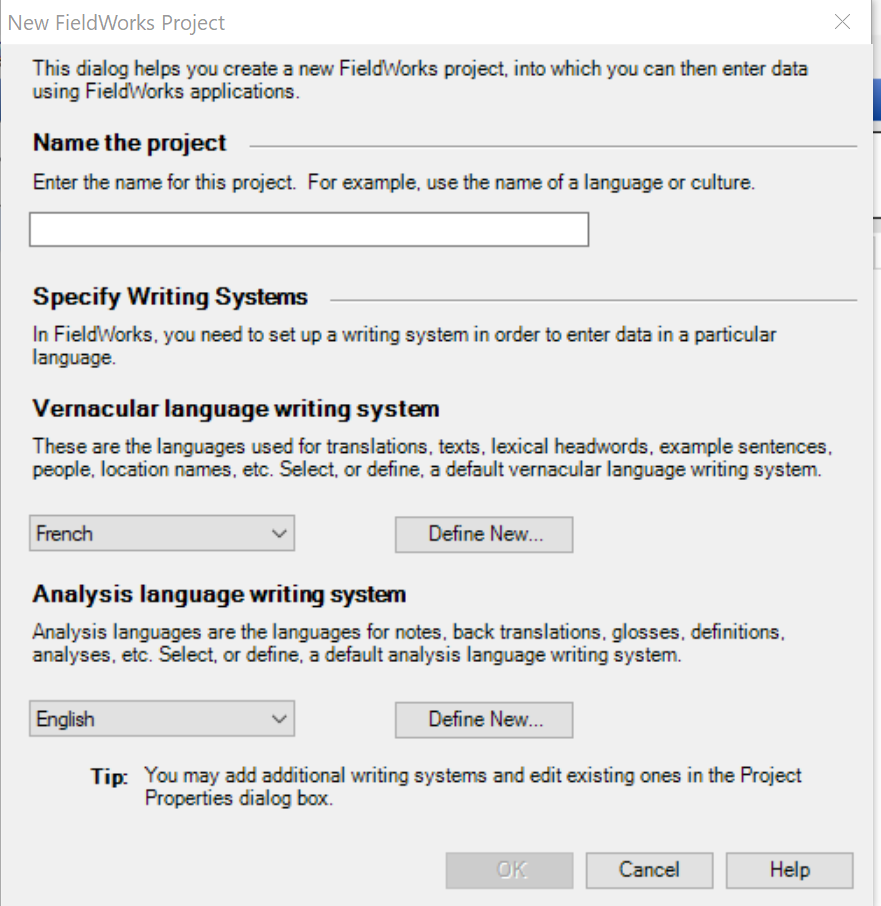
- Select the writing system you will use for the language you are documenting. For example, you might be using the Devanagari script, or IPA, or perhaps a standard or working orthography. A writing system will not show up unless you have it in your font file.
- Select a writing system for the language you will use for translating words and clauses (called glossing or annotating). This will probably be English.
- Once the project opens, on the lower left-hand pane, select “Texts & Words“.
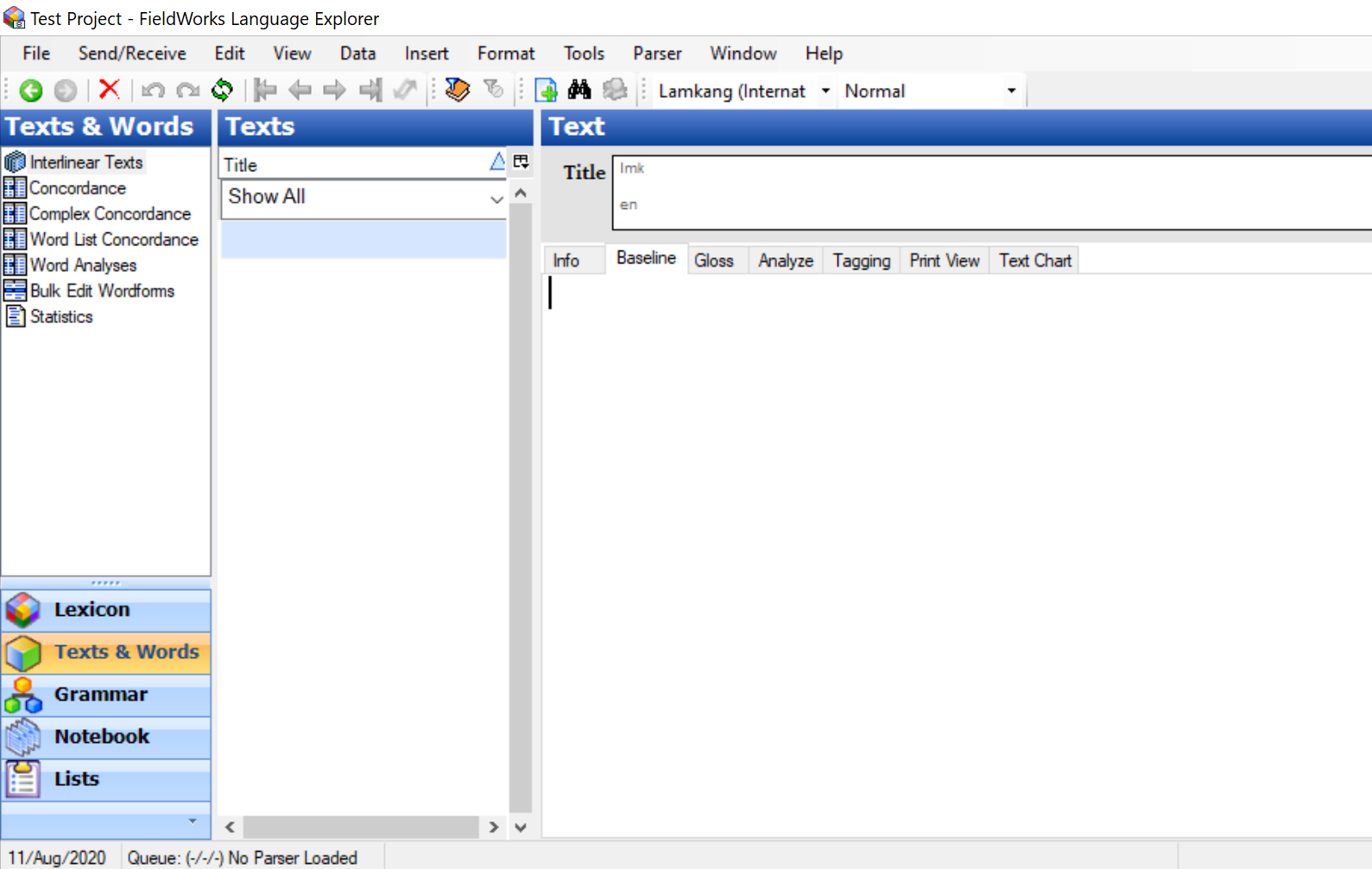
- Familiarize yourself with the three columns. The column on the very left is where you select if you are working on connected texts (like a story or conversation) or words for a dictionary. If you are working on connected texts, then you select “Texts & Words”. If you are adding individual words, you select “Lexicon”.
- Select “Texts & Words”.
- Add a new text by clicking on the green “+”.
- Now you can type or copy and paste the text you want to annotate in the tab “Baseline”.

- Once the baseline is entered you can move to the “Gloss” tab. Here, you can enter the meaning of each word, the part of speech of each word, and the translation of the clause. You can see the example of how this is done with the word “example”, which we have provided here with “word gloss” and “word category” where we have labeled it a noun.
- Now move to the “Analyze” tab. Here, you can give even more information on each word.
Notice how we have analyzed the word “texts” as being composed as “text” + “s”. Once we break those into two parts, “text”, and the plural marker “s”. We can also train the program to recognize the “s” makes a noun plural. The next time “s” appears, or “text” appears, the program will remember what we entered, and will fill that in automatically. In this sense, FLEx is a good companion. It won’t do the analysis for you, it won’t suggest new analyses for you, but it will remember your analyses and ask if that is what you want to use.
We review four ways to use FLEx to create a word list or dictionary.
- Add words by creating a lexical entry
- Add words from a connected text
- Add words with the “Collect Words” function
We also provide links to sample online dictionaries. We introduce you to Webonary.com where you can upload a FLEx-generated lexicon in an online format.
7.2 Add words by creating a lexical entry
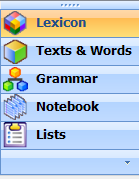
Figure 1: Screenshot of the “Lexicon” tab where the dictionary is located
Create a new lexical entry under the “Lexicon” tab by clicking on the red box with the green plus sign (+). This will open up a blank “New Entry” window. Here, enter the new lexeme form, morpheme type, a gloss, and grammatical information. If there are any entries similar to the one already in your Lexicon, these will display so you can avoid duplicates. Click “Create” to add the new entry to the Lexicon.

Figure 2: Adding a new lexical entry
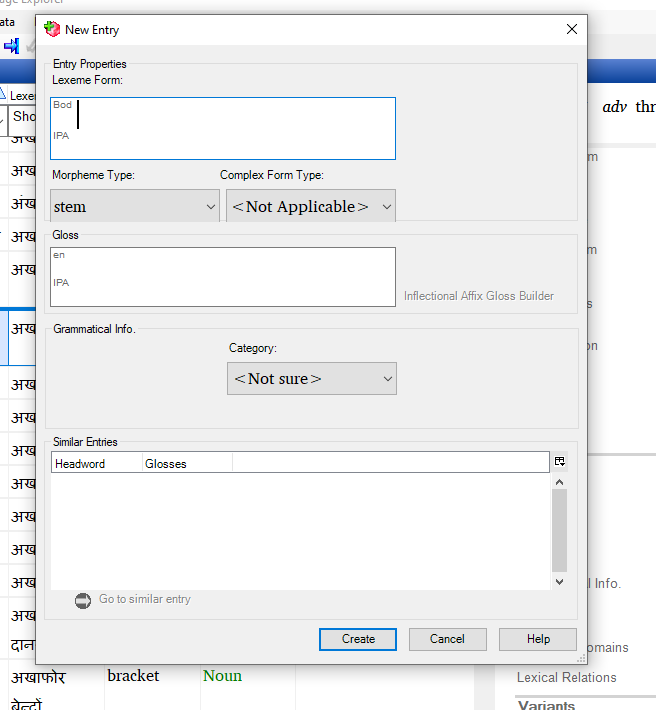
Figure 3: The “New Entry” window
In addition to the basic function of adding new lexemes, FLEx allows you to add various senses of a lexeme, allomorphs, notes on pronunciation, and additional notes. You also have the option to add a picture to your lexical entry. This is done in the “Lexicon Edit” fields.
Try this: create a lexical entry for a word of your choice. The lexical entry will include the following components:
- Lexeme Form – Provide a word or frozen phrase without additional morphology.
- Morph Type – Identify if this is, for example, a root or stem, bound or free, or enclitic.
- Citation Form – List how you want the word to be displayed in a dictionary (the headword).
- Note – Write ethnological, pedagogical, grammatical, or other notes not seen in the definition.
- Sense 1 – The primary meaning or use for the words/frozen phrase.
- Sense 2– A second usage or meaning for the word/phrase. (for example, “we went to see the play” versus “the children went out to play“).
- Gloss – Provide a one word equivalent in English.
- Definition – Provide a detailed explanation of the meaning.
- Grammatical Info – Identify the part of speech.
- Example – Provide a sentence or phrase showing the word in use.
- Components – Identify the stems or roots in the lexeme or phrase. For instance, a compound word will have two or more stems or roots.
- Semantic Domains – Identify the domain category (e.g., does it have to do with astronomy, cooking, education, etc.).
- Lexical Relations – List possible synonyms and/or antonyms.
- Picture – Provide a .jpg or similar illustrating the entry.
- Media File – Provide a sound file to assist with pronunciation.
- Publication Settings – Indicate if the item and entry can be publicly shared or are too sensitive to share.
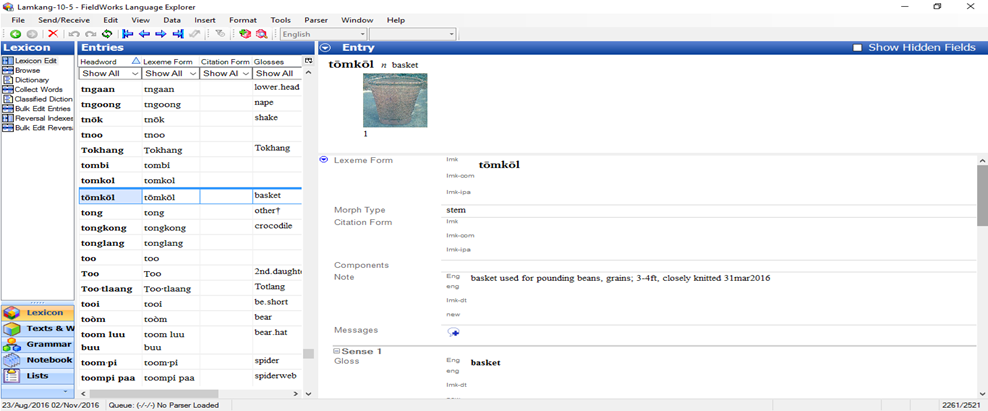
Figure 4: View of a single dictionary entry with a photo in FLEx
7.3 Add words from connected text
The “Texts & Words” tab provides a way to use connected texts (stories, speeches, conversations, for example) for identifying new words. Once glossed here, those words can be added to the lexicon. In Figure 5, for example, we see that the word zaiga has been glossed ‘place’. This gloss can be added to the FLEx lexicon by clicking on the green check mark with the plus sign. You can view the entry in the lexicon at your convenience and add additional information.

Figure 5: View of the Gloss tab in FLEx
7.3 Add words with the ‘Collect Words’ function
Add words to the lexicon using the “Collect Words” function. This can be accessed in the “Lexicon” tab by clicking on Collect Words.
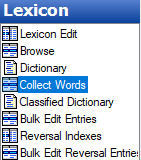
Figure 6: How to find the “Collect Words” function in FLEx
The semantic domains provided here can be used to prompt rapid collection and recall of lexemes. This function is limited in that you can only enter the word and the definition. However, you can always revisit your entry in the “Lexicon Edit” function to add more information.
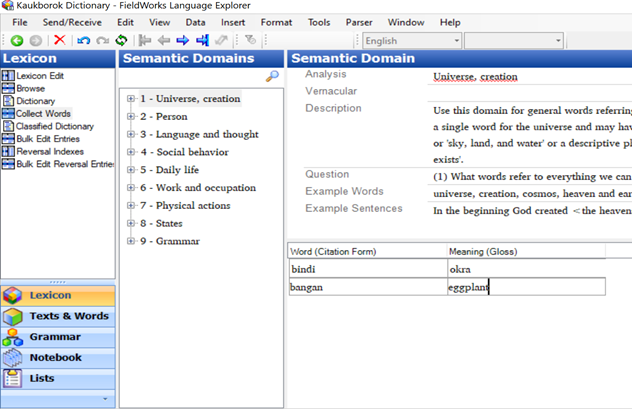
Figure 7: Using the “Collect Words” function in FLEx
7.4 Online Dictionaries and Webonary.com
Here are the links to a number of online dictionaries.
- Lakota: https://www.lakotadictionary.org/phpBB3/nldo4.php
- Ojibwe: https://ojibwe.lib.umn.edu/
- Karuk: http://linguistics.berkeley.edu/~karuk/index.php
- Passamaquoddy-Maliseet: https://pmportal.org/browse-dictionary
- Efate: https://paradisec.org.au/SELexicon/index-english/main.htm
A FLEx Lexicon can be formatted to create an online dictionary, such as those found on the SIL Webonary website. Webonary provides linguists and language communities a way to disseminate lexical information garnered through language documentation projects. The process of uploading and hosting a FLEx project is guided closely by Webonary staff who allow several reviews of the online spell out of the FLEx project. Webonary is one way of showcasing FLEx data.
Discussion:
- Which speech events need to be recorded to understand the grammar?
- How will different speech events provide context for teaching the language?
- What kinds of speech events give a comprehensive picture of the language?
5.8 Project
Create a FLEx project with Baseline, Gloss, Analyze tabs for a connected text of at least 100 words. Add at least 20 words to Lexicon using the “Lexicon Edit” and “Collect Words” functions. Add at least 100 words and 10 morphemes using SheetSwipe process. In your Analyze tab, show the use of hierarchical glossing. Use the concordance feature to experiment with searches on the hierarchical glossing either left or right of the colon, and note what grammatical insights are obtained through such searches.

